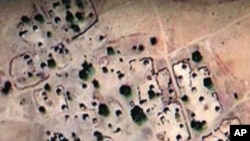<!-- IMAGE -->
Technology is transforming our lives. It's also transforming the way non-profit groups police human rights abuses around the world. Pictures taken from high in the skies are revealing gruesome stories -- as human rights organizations monitor the action from thousands of kilometers away.
In Darfur, destruction and violence are taking place in remote areas, difficult to reach because of restrictions imposed by Sudan's government. But because of an effort called Eyes on Darfur, the world can now monitor a dozen at-risk villages.
"There's large burn scars. You can tell. There will be ash rings where fences have burned down and the ash is a lighter color, they correspond exactly to the areas where there were buildings and where there were fences in the before imagery," explains scientist Susan Wolfinbarger.
Such photographs also helped confirm the discovery of a mass grave of two thousand Taliban troops, believed to be killed by the US-supported Northern Alliance. Susannah Sirkin of the group Physicians for Human Rights says the group discovered the grave and used satellite imagery to confirm their suspicions.
"When the satellite image came and we actually see the picture of the truck on the ground on that particular day, which means there wasn't clouds overhead and we have this clear image of what looks like an enormous excavator, it wasn't really shocking to us. But it confirmed what we had suspected, and now we had the proof that someone had ordered a big machine to remove probably bodies," says Sirkin.
This satellite technology is revolutionizing the way human rights groups uncover abuses. But there are challenges. They can be expensive. Remote villages often do not appear on maps or the government does not allow cartography of the region.
The Center for American Progress says the U.S. should upgrade the mapping database that's available to the public.
It also wants the government to notify human rights groups when it purchases images, so the groups can access them at a lower price.
New images cost $2,000, compared to $200 to order a duplicate.
But these groups agree, the real work comes after the photos are released.
"It's only one tool," Sirkin says, "And at the end of the day, it's human beings and governments and citizens of the world that have to decide how to stop these things and how to punish perpetrators."
And, that, she says, is the greater challenge.







